#Safavid period
Explore tagged Tumblr posts
Text

Small Dish with Stylized Rock Dove, Iran, Safavid period, c. 1675–1725.
241 notes
·
View notes
Text

Youth Holding a Pomegranate; Illustration from a Single Page Manuscript
c.1600–1650
style of Riza-yi Abbasi
(Iranian)
Iran, Isfahan, Safavid period (1501-1722)
Opaque watercolor and gold on paper
Image: 15.3 x 8 cm (6 x 3 1/8 in.); Overall: 27.7 x 16.4 cm (10 7/8 x 6 7/16 in.)
#Iranian art#iran#iranian#riza-yi abbasi#Isfahan#safavid#safavid period#Watercolor#opaque watercolor#Gold#1600s art#1600s#17th century
2 notes
·
View notes
Text

Kashan Traditional Bazaar
The construction of the Kashan Bazaar probably took place in the Seljuk era (circa 1000s and late 12th century), and there were some renovations during the Safavid period. The most famous part of the bazaar is the Timche-ye Amin od-Dowleh Plaza with a splendid dome. The bazaar complex comprises several mosques, tombs, caravanserais, arcades, and water reservoirs. The central row is around three kilometers long, and there are 120 shops inside the complex.
aminfadakarr


#aminfadakarr#photographer#kashan bazaar#iran#bazaar#seljuk#era#safavid period#timche-ye amin od-dowleh plaza#shopping#history
0 notes
Text

Composite album folio, Dancing sufis; Cluster of primrose, calligraphic panels. Artist, Master Murad. Calligrapher, Shah Mahmud al-Nishapuri. Iranian, Safavid Period. 1575 CE.
The Smithsonian National Museum of Asian Art.
#iranian#Iran#safavid#early modern period#early modern history#asian history#iranian history#1500s#art#culture#history#middle eastern history
149 notes
·
View notes
Text
went to my uni’s art museum yesterday as part of my islamic art history course and our prof (iranian, is fluent in (at least one variety of) arabic, this is relevant) was walking us through the pieces in the collection, and she gets to a written text (no illustrations, from the 15th or 16th century iirc) and she starts to talk about what it says and she pauses for a second,, leans in,,, and says “this is upside down”. apparently whoever set the Islamic Art display up for our Islamic Art History class couldn’t recognize how to orient arabic the right way round
#there was also some geography/time period labels she disagreed with looool#there were some tile pieces from ‘20th century’ and she was like a lot of islamic/arabic/middle eastern pieces from this era are stolen#not that these ones are stolen! but a lot of pieces from other museusm are stolen#im just thinking no you can say it. they’re probably stolen#i mean it’s super cool look at a turkish hilye and playing cards from the safavid period. one has to wonder how a midwestern state universit#came to possess such items.#anyways. im super enjoying this class esp after my last art history class i think i’m gonna pick up a minor :]#i’m already getting a linguistics degree so might as well get another unemployable qualification
3 notes
·
View notes
Text


Historically Accurate Jasmine
Another remake! I remade Jasmine for my series of "Historically Accurate" Disney Princesses. I honestly don't like the first version of Jasmine I made five years ago. It's not well drawn, I don't like the design, it doesn't look Jasmine and I incoherently mixed elements from different time periods. I also made some embarrassing blunders in history while explaining my thought process, since back then I was much less familiar with the history of Middle East and India. So I definitely wanted to redo her.
I do like Aladdin a lot, but let's be real, it's a very Orientalist film. Orientalism is the colonial lens through which the west looks at Asia and North-Africa, or the so called "Orient". It's dehumanizing and fetishistic lens - the west at the same time despises and covets the "Oriental" body. The "Orient" is flattened as one single entity and it's all savage and exotic, backward and mystical. Orientalism is fueled by jealousy and entitled superiority. In Aladdin it's very visible in how the setting blends a lot of very different Asian cultures, flattening large parts of a very diverse continent. It's set in sandy desert, but a lot of the elements of dress especially are much more Indian in aesthetic. Certainly fitted bodices and exposed stomachs are not practical clothes in a desert climate. The characters too are frequently exotised and fetishised with most female characters including Jasmine dressed and posed to appeal to the colonial gaze that covets brown bodies. Jasmine is sexualised much more that any of the white Disney princesses.
Originally the story was going to be more focused, though I can't imagine it ever lacking in Orientalism. It was supposed to be set in Baghdad, but during the production the First Gulf War happened, so they tried to distance it from the original Iraqi setting by setting it to the fictional city of Agrabah. Would there have been less Indian elements? Probably. It is pointed that in the wake of American forever wars in the Middle East, to not cause a stir Disney elected to make the movie more Orientalist. Orientalism was the inoffensive option.
Deciding on the historical setting to ground the redesign in was not simple considering the mess that the movie's setting is. One Thousand And One Nights is a collection (or many collections) of Islamic folktales from Northern Africa to Central and South Asia. So India (especially Mughal India ruled by Muslim dynasty) wouldn't be an incorrect setting and certainly neither would Middle East. The problem is that the film seems to imply there's no meaningful difference. Rather than trying figure out what is the most fitting place and time period for the film, I looked to the origins of the story of Aladdin. Apparently Aladdin’s story was added to One Thousand And One Hundred Nights by a French translator in 1709. He got the story from a Syrian-born Maronite storyteller, Hanna Diyab, who might have come up with the story himself. Most of Syria (at least Aleppo where he was born) was at the time part of Safavid dynasty Persia, so I decided to set my version of Jasmine in 17th century Persia.
I basically based the design on the illustration from 1702-3 by Mu'in Musavvir first below. The more fitted and tailored style with wider skirt likely influenced by European fashion it represents became fashionable in mid 17th century, so it still fits the time period I'm aiming at. The colour is simply perfect for Jasmine and I really like the overall desing. I did look at other art as well to get a better understanding on how the cut of the dress works, so here's couple o more references: second one is "Two Lovers with a Servant Woman" from 1696 by Mu'in Musavvir as well, third and fourth are details from paintings in the Chehel Stoun palace in Isfahan from 1646. Eyebrows grown together was considered especially beautiful feature so of course I gave Jasmine brows like that.
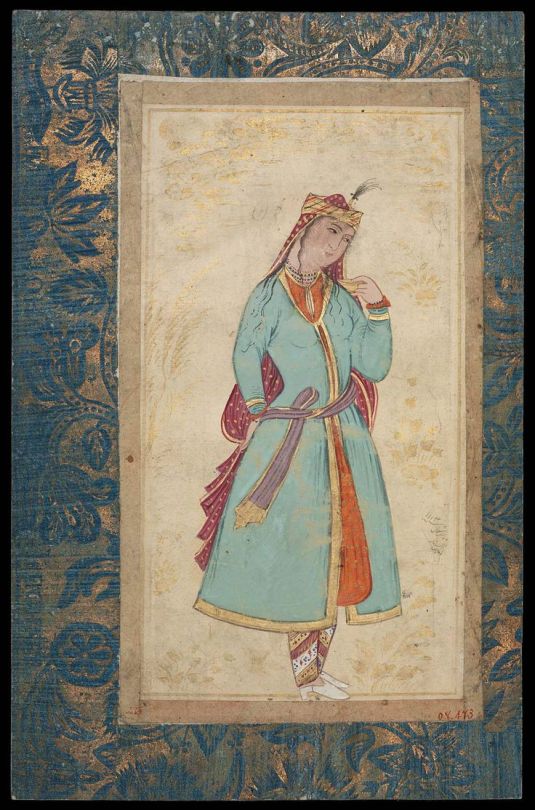
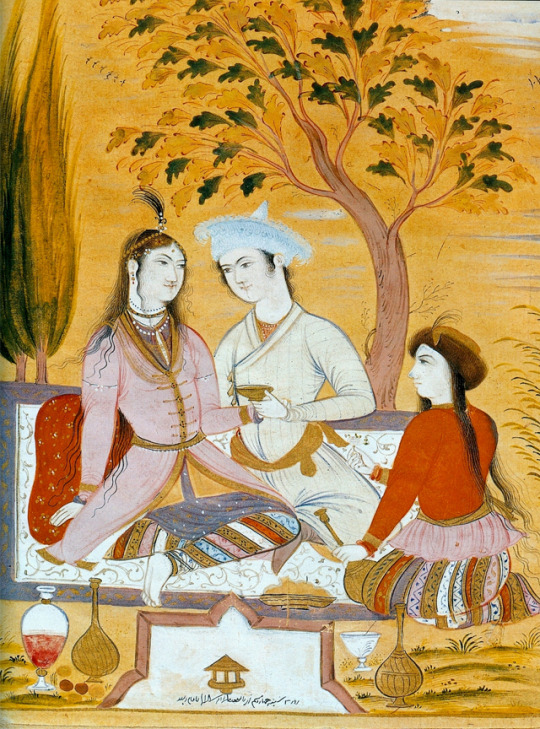

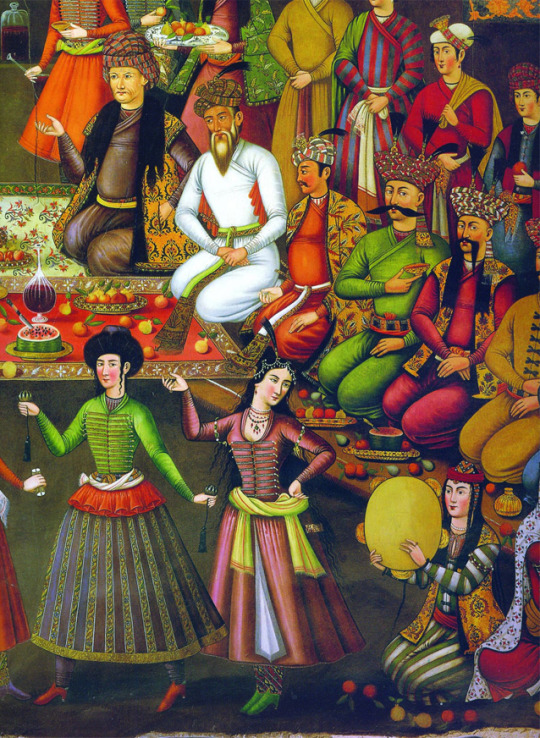
I of course gave her a crown, since she's a princess and depictions of Safavid princesses seem to always have a crown. I found that usually in art women had a white veil with their crown which is why I made her veil white, even though with the scarf band, which was the more typical headwear for women, colourful veils seemed to have been much more popular at the time. The veils in 17th century were also very long. For the crown and jewelry I wasn't as concerned to be using references from mid to late 17th century specifically, since these tend to change slower than other fashions. I based the crown mostly on the first illustration below from c. 1600 by Muhammad-Sharif Musawwir of a Seated Princess and the earrings on the second illustration from c. 1540 by Mirza ‘Ali of a Seated Princess with a Spray of Flowers.


Most of the images I found on this very useful blog which had gathered A LOT of Persian illustrations and paintings in handy timeline. A lot of the information of Safavid fashion I got from this MET Museum write up by Nazanin Hedayat Munroe.
#historically accurate disney princesses#historical fashion#fashion history#fanart#disney fanart#disney#history#art#my art#aladdin#disney princess#safavid fashion#safavid empire#persian fashion
444 notes
·
View notes
Text
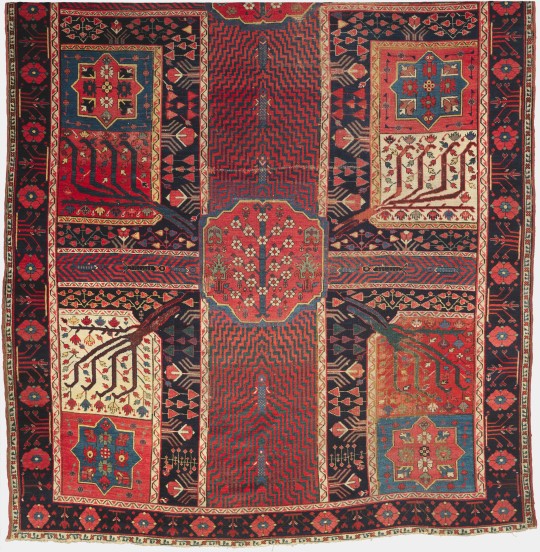
Garden Carpet, 1800, Safavid Period, Iran.
417 notes
·
View notes
Text
After nearly an entire year of scheming and working with Guest Artist, Arlo Teague, I am so incredibly proud to present our silk scarf, Puzzle Horse.

In soft shades of blush and lavender mauve, four finely dressed dappled ponies prance and leap in an interlocking puzzle. The design pays homage to an illustration made during the Safavid Period of Persia (modern day Iran).

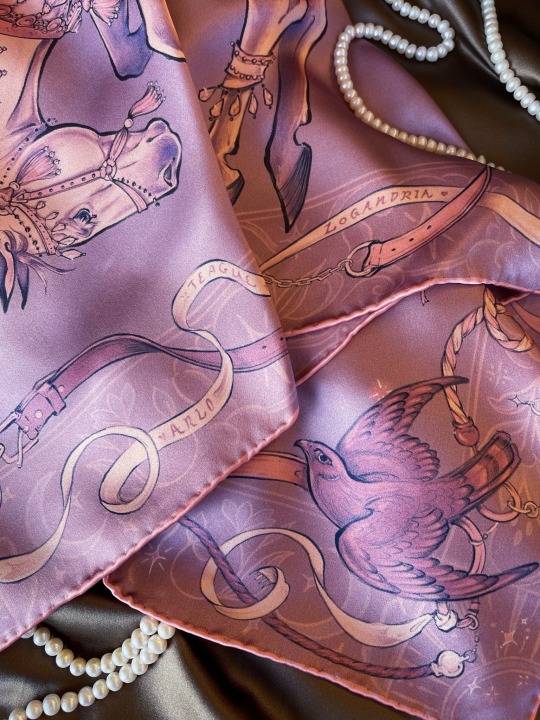
Surrounding the horses is a border dedicated to falconry, some of the oldest records and artwork of which are from Ancient Persia. Two falcons loyally encircle the horses, while a border of celestial bodies, ribbons, and horse tack twirls around the edges of this dusk-colored scarf.



This medium-sized silk satin neckerchief looks fabulous loosely draped or knotted chicly at the throat, worn in the hair, tied to a purse strap, or styled in whatever other way you can dream up.
The silk is mirror-printed on both sides of the fabric, so the illustration is perfectly vibrant from all angles, regardless of how you choose to tie it.


This illustration is limited to an edition of only 150 pure silk neckerchiefs will never be reprinted.
You can find it here: https://logandria.com/collections/silk-scarves/products/puzzle-horse-65cm-silk-scarf
#silk scarf#fashion#glamor#equestrian outfits#equestrian fashion#equestrian#art#illustration#art history#medieval art#middle eastern art#ancient persia#ancient art#outfit
133 notes
·
View notes
Text

~ Rudaba letting down her hair ~
-
Primarily based on an illustrated manuscript from Safavid Iran (museum didn’t specify a date smh just its era) The rim of the tower came from a different manuscript that is older than the Safavid period but I digress. I started with that trim and switched the year last minute
#persian art#mythology#fantasy#rapunzel#middle ages#(not rapunzel nor the Middle Ages lmao but the audience reach is there)#misc art tag
125 notes
·
View notes
Photo

Persian Rose-and-Nightingale Paintings
Rose-and-nightingale paintings and patterns (gul-u-bulbul) are a subtheme of the bird-flower (gul-u-morḡ) genre in Persian art. Bird-and-flower paintings are of Chinese origin and include pictorial elements such as flowers and plants, birds, and occasionally butterflies. This motif was then appropriated by the Persians and throughout the centuries evolved from being a decorative element within the art of books to an independent genre of painting.
Both the rose and the nightingale have important status within Persian art and literature, with roses also having a conspicuous role in Persian traditions, ceremonies, and economics. From the pre-Islamic era and Zoroastrian rituals to the Islamic period, roses have enjoyed a significant position both symbolically and practically. Roses have been associated with the prophets of Islam, especially Prophet Muhammad (570-632 CE), and they were one of the main Persian exports during the Safavid era (c. 1501-1739), which also contributed to their more abundant presence in art. The importance and presence of this motif increased so much during the Qajar Dynasty (1794-1925) that it even came to symbolize the country itself. The word 'rose' (gul) also became a generic term for all flowers. As Layla S. Diba notes:
The bird and flower decorative theme was one of the most prominent in Persian art, originating in manuscript illustration and evolving as a decorative motif and independent painting genre. This theme enjoyed such popularity due to its universal appeal and range of both earthly and divine floral meanings which it conveys. (12)
Origin
The bird-and-flower subject was popular in China from the early Tang Dynasty (618-907) and was one of the major types of Chinese painting which included birds, flowers, insects, and pets. Chinese artist-scholars depicted this motif using different stylistic and technical approaches ranging from realistic to overtly expressionistic. Regardless of the method of painting, the bird-and-flower motif had a symbolic meaning and reflected the ideas of the artist-scholar. Although the bird-and-flower theme (especially roses) had been used in Persian literature and poetry since the 11th century and throughout its golden age, it only appeared within the art of books during the Ilkhanid period in the 14th century due to Chinese influence.
Continue reading...
26 notes
·
View notes
Text
Neurodivergent Study Tips
A teacher at my school asked me if I had any study tips for other students with ADHD, Autism, Anxiety, ect. so I typed up a little list. Thought others might find it helpful as well! Sorry it's so long. This is just my experience, so they probably won't work for everyone, I would love it if everyone could add on there own things they do to stay focused.
Do you have something that you’re really obsessed with whether it be a piece of media, a video game, a book, a certain subject or a time period in history? Try to relate it to what you are learning!
-Use mnemonic devices related to your special interest or current thing you’re really into.. When I often need to memorize certain terms I like to make my mnemonic devices relate to the tv shows I like (ex. I needed to memorize the three main gunpowder empires so I used the term “Silly Oncologist Man” which reminded me of Wilson from House MD but the first letter of each word matches the name of each gunpowder empire; the Safavids, the Ottoman Empire, and the Mughal Empire.)
-Relate the things you like to what you are learning about. Find a way to tie in the things you enjoy into what you are learning about. For math and science this can be quite easy, especially when you are learning about motion and other things that can be applied easily to many scenarios (I turned all my equations on calculating the motion of an object into playing roller derby or throwing projectiles in dnd or video games I like) For me I often relate political movements in fictional TV shows to the part of American history or philosophy they most align with, I find that any TV shows with complex fictional governments or that explore certain themes and ideologies are good for this (I used the Battlestar Galactica Reboot for this, but you can really use anything that you’re interest in, even other parts of history, this can also help you develop a deeper understanding!)
-Find some way to fit something you like or what you’re interested in into your study routine. I often have the soundtracks of my favorite tv shows, movies or video games playing in the background as I study, or I often keep something that reminds me of the things I like nearby. (I like drinking coffee while studying because it helps me focus and reminds me of my favorite character Ianto from the tv show Torchwood, similarly I also have a scented candle I like that smells like the Sunnydale Library from Buffy the Vampire Slayer burning while I work)
Find ways to reward yourself for studying.
- Make a tangible final product. I often find that making a tangible product relating to what I’m learning or what I’m interested in can be quite helpful. For example, instead of just forcing myself to memorize all the neurotransmitters and parts of the brain for AP Psychology I made up a fake video game where each of the neurotransmitters was a member of an alien punk band and the parts of the brain were places they went on tour. I was able to make little skill trees for each of the neurotransmitters as their character leveled up relating to the effects of what would happen if you had too much or too little of that neurotransmitter, also allowing me to memorize the different causes of mental illnesses at the same time. At the end of this project not only did I have a little booklet and ton of sketches of my neurotransmitter characters, as well as many accompanying pinterests boards but I also memorized all the terms I needed to know, often in far more depth than my classmates because I would look up additional information to complete my project. Plus if you have something you can take with you outside of school and show to other people it often leaves you feeling much more fulfilled.
-Use Technology I use a lot of study and task tracking apps to motivate myself to study. My favorites are the ones that tie you studying to taking care of some kind of virtual pet or gaining in game items. My favorites are Study Bunny which allows to gain coins every time you study to better take care of your virtual bunny, Finch which is more of a self care app but you can also use to set goals for the day to take care of your virtual pet bird, Focus Traveller which also lets you make soundscapes and travel a mountain by studying more, Habitica a fantasy themed task managing app where you get coins and equipments for completing tasks and Hatch where you get to hatch alien creatures for studying. You can also use rewards not tied to an app but tied to something you like to do or something that you are interested in, but I also just like the apps.
-Make your place to study actually fun to be in. I know this can be a lot harder for some people depending on if you actually have your own space at home. But you can even bring a cute action figure or good luck charm to put with you while you study, or just find a place in your school where you like to be (I have a favorite spot in my school library where I love to sit in for studying.) Your environment could also include playing the kind of music you like while studying or creating a special soundscape with calming sounds like rain or birds. I also often like lighting a scented candle or incense while I work because I really like good smelling things and it makes me happy to be at my desk. I also just have fun stickers on my laptop and a cute computer mouse that has just the best texture, making me happy to work.
Find ways to prevent yourself from leaving your desk or stopping the task you are doing.
Create a reason why you can’t leave your study space or stop your task. For this I often like to light a scented candle because I can’t leave an open flame unattended for more than a few minutes because my cat Gus has a death wish. So because I don’t want to waste matches I often find myself staying put and continuing to work as opposed to getting up and wandering the house to go bother the rest of my family. You can also use an app like Study Bunny or Hatch that sets a timer for how long you need to stay put.
Incorporate movement into your studying. I am often very very fidgety and find myself often leaving my desk to wander around the house if I haven’t moved for long enough. Instead I have started pacing while reading my textbooks or using a fidget while studying so I can still get some movement in. My mom has a little mini elliptical thing she keeps under her desk which she finds very helpful as well, though that can be a bit expensive.
Limit technology based distractions. Apps like Study Bunny or Hatch will stop you from accessing the rest of your phone without losing your progress, which can stop you from getting distracted and texting your friends or scrolling social media. I also have the software Virtual Cabin which not only makes it feel like you are studying in a cozy cabin with a cute cat/dog and nice music/nature sounds but also blocks the rest of your computer from view, keeping yourself focused on whatever you are doing. Frankly I just find myself trying to do assignments on paper/analog as much as I can because it eliminates the temptation of me switching out of what I am doing and looking at something else on my computer.
Find ways to hold yourself accountable. I often find that telling someone that I am going to do homework before I do it can be helpful. I even sometimes tell them what assignments I am doing so they can check in to see if I actually did them, though I often find this a bit stressful. My best suggestion is to find someone who understands how your brain works so they won’t shame you if it gets in the way of you doing work and they can even help come up with new strategies for working more effectively. For example I often tell my penpal that I am doing homework because they believe in me but they also have issues focusing and staying calm sometimes so they understand if sometimes that stuff gets in the way. You can also just sit with someone very quietly and work next to them this is called “body doubling” and I find that if I am working while someone else is working I feel more motivated to work and less likely to go through social media, because frankly I don’t want them to see the weird crap that I google when I’m trying to avoid doing homework (way too many questions about the lore surrounding video games I’ve never played and have no intention to play, and many weird questions for my various creative writing projects.)
#adhd#studying#studyblr#autism#school#high school#university#house md#torchwood#actually autistic#neurodivergent#study tips
44 notes
·
View notes
Text
109 is fake, 32 is real
Muslims have faced at least 32 major expulsions in the last 1000 years. I’ve compiled a list for your reference. You can help by expanding it.
Interestingly, Muslims have faced more expulsions than Jews in the same time period. In fact, their history starts with an expulsion! Why is that, I wonder?
But wait! Weren’t the Jews expelled 109 times?
Actually, no. The 109 meme is utterly false. The actual number is closer to 20. Here’s why:
It counts expulsions done in stages from the same country as multiple expulsions. For example, it counts France 5 times even though these were different waves from the same expulsion.
It artificially divides countries into regions to increase the count.For example, it counts different cities within the Holy Roman Empire as different expulsions even though they’re all in the same country and happened in the same time.
It depicts immigration as expulsion. For example, while many Jews did leave Iran after 1979, the regime never expelled them. They simply didn’t want to live under an Islamic Republic. Many Muslims have left as well.
It just plain makes up events. For example, it mentions an expulsion of Jews from Morocco in the 15th century. Morocco famously accepted Jewish refugees in the 15th century, making the claim the literal opposite of the truth.
In any case, here’s my list of Muslim expulsions in the last 1000 years. It is by no means exhaustive. If I’ve missed something, please let me know in the comments!
Country: Byzantine Empire Date: 1000s Perpetrators: Byzantine rulers Estimated number expelled: Tens of Thousands
Country: Sicily Date: 1061–1300s Perpetrators: Normans Estimated number expelled: 100,000
Country: Kingdom of Jerusalem Date: 1099 Perpetrators: Crusaders Estimated number expelled: Tens of thousands
Country: Edessa Date: 1144 Perpetrators: Zengi and Crusaders Estimated number expelled: Thousands
Country: France Date: 1300 Perpetrators: King Philip IV of France Estimated number expelled: Thousands
Country: Spain Date: 1492–1614 Perpetrators: Catholic Monarchs Estimated number expelled: 300,000
Country: Portugal Date: 1496–1497 Perpetrators: Portuguese Crown Estimated number expelled: 10,000
Country: Safavid Persia Date: 1500s–1700s Perpetrators: Safavid Shiite regime Estimated number expelled: 500,000
Country: Ottoman Empire Date: 16th–17th c. Perpetrators: Ottoman Sunni regime Estimated number expelled: 100,000
Country: India (Bengal)Date: 1757Perpetrators: British East India CompanyEstimated number expelled: Several thousand
Country: Russian Empire (Crimea)Date: 1783Perpetrators: Russian Empire under Catherine the GreatEstimated number expelled: Around 200,000
Country: Russian Empire (Circassia)Date: 1864Perpetrators: Russian Empire under Tsar Alexander IIEstimated number expelled: 1.5 million
Country: Wahhabi Arabia Date: 18th–19th c. Perpetrators: Wahhabi movements Estimated number expelled: 100,000
Country: India (Under British control)Date: 19th centuryPerpetrators: Mughal EmpireEstimated Number Expelled: Tens of thousands
Country: Bulgaria Date: 19th–20th c. Perpetrators: Bulgarian nationalists Estimated number expelled: 300,000
Country: Greece Date: 1923 Perpetrators: Greek state Estimated number expelled: 500,000
Country: Soviet Union (Chechnya, Ingushetia, and Crimea)Date: 1944Perpetrators: Soviet UnionEstimated number expelled: Around 700,000
Country: India Date: 1947 Perpetrators: Partition violence Estimated number expelled: 8,000,000
Country: Israel Date: 1948 Perpetrators: Israeli state Estimated number expelled: 700,000
Country: Jordan Date: 1970–71 Perpetrators: Jordanian Army Estimated number expelled: 20,000
Country: Nigeria Date: 1960s-1970s Perpetrators: Nigerian government, ethnic violence Estimated number expelled: Tens of thousands
Country: Ethiopia Date: 1970s-1990s Perpetrators: Ethiopian government Estimated number expelled: Tens of thousands
Country: Uganda Date: 1972 Perpetrators: Idi Amin Estimated number expelled: 30,000
Country: Cyprus Date: 1974 Perpetrators: Greek Cypriot militia Estimated number expelled: 60,000
Country: Myanmar Date: 1978–present Perpetrators: Myanmar military Estimated number expelled: 1,200,000
Country: Sri Lanka Date: 1990s Perpetrators: Tamil Tigers (LTTE) Estimated number expelled: Tens of thousands
Country: Afghanistan Date: 1990s–present Perpetrators: Taliban Estimated number expelled: 100,000
Country: Kuwait Date: 1991 Perpetrators: Kuwaiti state Estimated number expelled: 400,000
Country: Bosnia Date: 1992–1995 Perpetrators: Serbian forces Estimated number expelled: 1,200,000
Country: Yugoslavia (Kosovo) Date: 1998–1999 Perpetrators: Serbian forces Estimated number expelled: 800,000
Country: Central African Republic Date: 2013–2014 Perpetrators: Anti-balaka militias Estimated number expelled: 100,000
Country: China (Xinjiang) Date: 2017–present Perpetrators: CCP Estimated number expelled: 1,000,000+
URI KURLIANCHIK
MAR 15
14 notes
·
View notes
Text

Incident in a Mosque/Divan of Hafiz. Persian. Safavid Period. 1530
9 notes
·
View notes
Text

Puzzle Sketch of Four Horses. Persia, Safavid. 1616.
The Smithsonian National Museum of Asian Art.
#art#culture#history#safavid#early modern period#early modern history#Persia#persian history#iranian history#Iran#middle eastern history
190 notes
·
View notes
Text

Pari Khan Khanum (1548–12 February 1578, aged 29) was a Safavid princess, the daughter of the Safavid king (shah) Tahmasp I (r. 1524 – 1576) and his Kumyk consort, Sultan-Agha Khanum. An influential figure in the Safavid state, Pari Khan Khanum was well educated and knowledgeable in traditional Islamic sciences such as jurisprudence, and was an accomplished poet.
She played a crucial role in securing the succession of her brother Ismail II (r. 1576–1577) to the Safavid throne. During Ismail's brief reign, her influence lessened, but then increased during the reign of Ismail's successor, Mohammad Khodabanda (r. 1578–1587), even becoming the de facto ruler of the Safavid state for a short period. She was strangled to death on 12 February 1578 at Qazvin because her influence and power were perceived as dangerous by the Qizilbash.
16 notes
·
View notes
Text

Persian [Created in Tabriz, Iran], The Shahnameh of Shah Tahmasp [The 'Houghton Shahnameh']: fol. 23v, Tahmuras Defeats the Divs, ca. 1525, Safavid period, illumination (The Metropolitan Museum of Art, New York)
Happy Nowruz to all those celebrating today!
#persian art#islamic art#manuscript#illumination#book#art#painting#miniature painting#safavid#16th century
31 notes
·
View notes